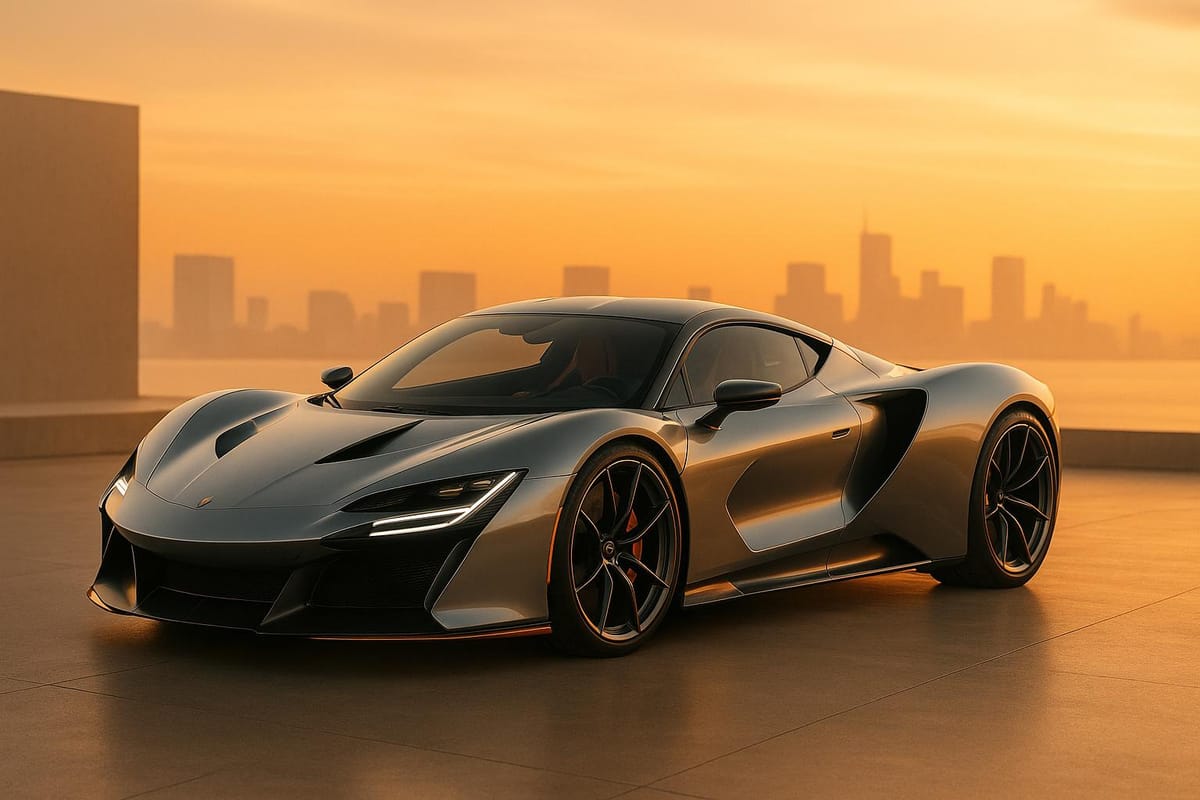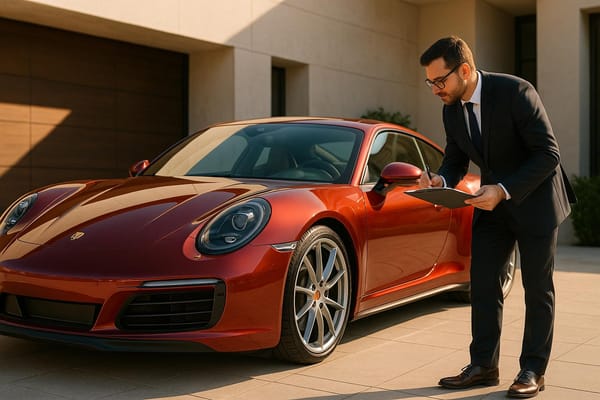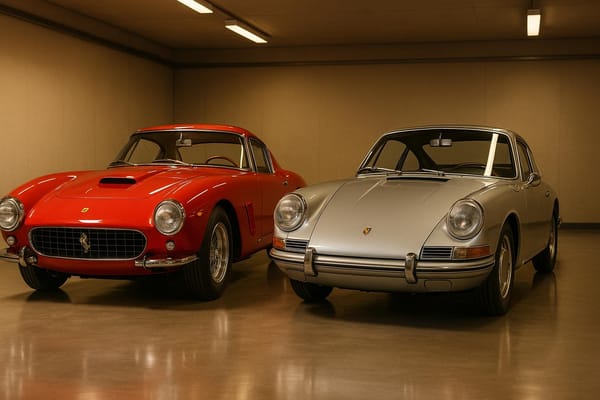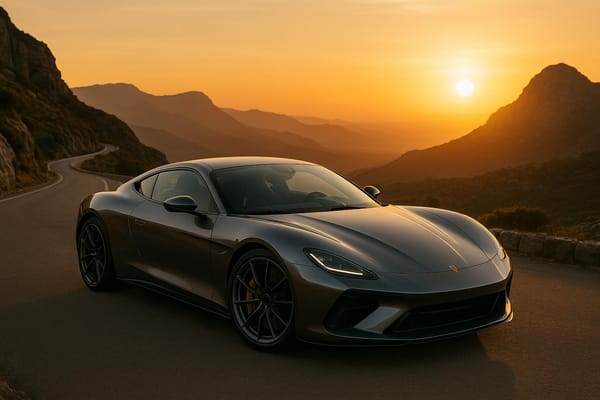2035 CO2 Rules: Impact on Supercar Values
The 2035 EU CO2 regulations will redefine supercar values, impacting petrol, hybrid, and electric models uniquely in the collector market.

The 2035 EU CO2 regulations will ban the sale of new petrol-only cars, pushing the supercar market into three categories: petrol, hybrid, and electric. Each faces unique opportunities and challenges, especially for collectors and investors. Here's what you need to know:
- Petrol Supercars: Rare models are becoming highly collectible, with demand driven by their heritage, sound, and driving experience. Expect premium valuations, but post-2035 usage restrictions could apply.
- Hybrid Supercars: A transitional option blending petrol and electric tech. Limited-edition hybrids with cutting-edge features could hold value, but long-term collectibility is uncertain.
- Electric Supercars: Aligned with future regulations, electric models are gaining popularity. Innovations and limited production runs are boosting their investment appeal, with some models already outperforming petrol cars in value retention.
Quick Comparison
| Category | Key Benefits | Key Drawbacks | Value Outlook |
|---|---|---|---|
| Petrol | Heritage, rarity, and driving experience | Likely usage restrictions post-2035 | Premium valuations |
| Hybrid | Advanced tech with petrol performance | May become outdated as EVs dominate | Moderate growth |
| Electric | Fully compliant with future regulations | Market acceptance still evolving | Strong potential |
The supercar market is splitting into two paths: petrol classics and electric pioneers. If you're considering investing, focus on rare, limited-edition models now while keeping an eye on the growing electric segment.
The EU's 2035 Fossil-Fuel Car Ban Explained
1. Pure Petrol Supercars
The 2035 CO2 regulations are reshaping the landscape for pure petrol supercars. With Europe planning to ban the sale of new petrol-only vehicles, collectors are turning their attention to existing models. Limited-edition petrol supercars, especially those marking the end of naturally aspirated engines, are expected to see a surge in demand.
Three key factors drive this interest:
- Rarity: As new petrol-only cars disappear from the market, the exclusivity of these vehicles is likely to grow, making them highly sought after.
- Historical Value: These cars represent standout achievements in design and engineering, which many collectors find irreplaceable.
- Driving Appeal: The sharp throttle response and distinctive sound of naturally aspirated engines offer a driving experience that electric vehicles can’t replicate. As electrification takes over, this experience becomes even more prized.
However, not all petrol supercars will gain the same level of interest. Models with limited production runs, cutting-edge engineering, and a strong heritage are better positioned to hold long-term value. Additionally, specialised maintenance and preservation will play a crucial role in keeping these vehicles in prime condition as they become rarer.
For those interested in this shifting market, MARQHAUS provides a carefully curated platform showcasing rare, investment-worthy supercars, celebrating their legacy and performance.
With these changes in mind, it's time to look at how hybrid supercars are shaping up in this evolving market.
2. Hybrid Supercars
Hybrid supercars combine petrol engines with electric motors, offering a middle ground as Europe moves towards stricter CO2 regulations by 2035. These vehicles appeal to those who are not ready to make the leap to fully electric cars but still want to reduce emissions.
Car makers are increasingly adding hybrid systems to their supercars to meet emissions targets without sacrificing performance. A prime example is the Ferrari SF90 Stradale, which proves that hybrids can deliver both speed and efficiency.
What Sets Them Apart:
- Enhanced Performance: Electric motors provide instant torque, boosting acceleration.
- Emissions Compliance: Reduced emissions help manufacturers meet regulatory standards.
- Engineering Excellence: Features like energy recovery systems highlight cutting-edge technology.
Despite their advantages, hybrid supercars face challenges in terms of long-term value. Being a transitional technology, they may struggle with collectibility over time. However, limited-production models that achieve technological milestones often hold their value better.
Factors That Impact Value:
- Battery longevity and the cost of replacements can influence ownership costs.
- As fully electric technology advances, hybrids risk becoming outdated.
- Access to specialised servicing will play a key role in their market appeal.
For collectors and enthusiasts, limited-edition hybrid supercars with notable advancements could be a smart investment. These vehicles represent an important phase in the evolution of performance cars.
3. Electric Supercars
The 2035 CO2 regulations are reshaping the supercar market. While petrol and hybrid models face changes, the electric segment is evolving rapidly, presenting new opportunities for collectors and investors.
Electric supercars are gaining traction, with UK registrations for 2024 showing a 41% year-on-year increase. According to the Knight Frank Luxury Investment Index, electric hypercars appreciated by 18% in 2024, compared to just 6% for petrol models. A standout example is the Rimac Nevera, which achieved private resale prices of £2.4 million - 60% above its original value. These trends highlight the growing appeal and long-term potential of electric supercars.
Classic car analyst Dietrich Hatlapa offers insight into this shift:
"We're seeing a new generation of collectors under 40 prioritising tech innovation over engine provenance. The 2035 regulations will likely create two distinct markets - pre-ban combustion icons and post-ban electric pioneers."
Residual Values and Market Trends
Electric supercars are showing strong retention rates, as illustrated by market data:
| Model | Initial Price | 3-Year Residual | Retention Rate |
|---|---|---|---|
| Porsche Taycan Turbo S | £201,000 | £142,500 | 71% |
| Rimac Nevera | £1.5M | £2.4M | 160% |
These figures underscore the growing confidence in electric models as investment assets.
Technical Factors
Electric supercars face range degradation of about 2.5% annually, which pushes manufacturers to develop better battery solutions. Beyond performance, practical considerations like maintenance and ease of ownership also influence their market value.
Charging Infrastructure
Public charging infrastructure in the UK is improving, with 96% of motorway services now offering 150kW+ charging options. However, private charging setups can cost between £15,000 and £25,000, adding to ownership expenses.
Market Outlook
Data from Cap HPI reveals that electric supercars achieve average three-year residual values of 65%, outperforming petrol models, which average 58%. This trend suggests a strong market for electric vehicles in the coming years.
Key Investment Factors
For collectors, the following elements are critical when evaluating electric supercars:
- Limited Production Runs: Models produced in small numbers tend to retain value better.
- Technological Advancements: Cutting-edge features and innovation command higher premiums.
- Brand Reputation: Established manufacturers instil greater confidence among buyers.
As the 2035 deadline approaches, early adopters of notable electric models may find themselves well-positioned in the evolving supercar market. Platforms like MARQHAUS reflect this shift, showcasing a curated selection of forward-thinking electric supercars.
Benefits and Drawbacks
The 2035 CO2 regulations are set to favour electric vehicles, restrict pure petrol models, and position hybrids as a temporary bridge between the two.
Market Impact Analysis
Regulatory compliance is the driving force behind market shifts. Pure petrol supercars could face usage restrictions after 2035, while electric models align seamlessly with the new standards. Hybrids, on the other hand, serve as a short-term solution, bridging the gap between traditional and fully electric options. These regulatory changes directly influence the investment appeal of each category.
Investment Considerations
-
Pure Petrol Supercars
These models are prized for their heritage and emotional appeal, making them a collector's favourite. Even with expected post-2035 restrictions, their value among enthusiasts remains strong. -
Hybrid Supercars
Hybrids combine cutting-edge technology with elements of traditional supercars. While they hold promise in the current market, their long-term desirability is less certain. -
Electric Supercars
Electric models are fully aligned with future CO2 regulations and are increasingly appealing to collectors who prioritise innovation and sustainability.
Performance and Technology Trade-offs
| Category | Key Benefits | Key Drawbacks |
|---|---|---|
| Pure Petrol | Strong heritage and emotional connection | Usage restrictions likely post-2035 |
| Hybrid | Merges advanced tech with classic traits | Longevity in the market is uncertain |
| Electric | Fully compliant with future regulations | Market perceptions still evolving |
The shift in the automotive industry presents both opportunities and challenges for collectors and investors. Platforms like MARQHAUS continue to highlight vehicles that meet current market demands while staying ahead of regulatory changes. These trade-offs will shape the supercar market's future trajectory.
Conclusion
The 2035 CO2 regulations are set to reshape the supercar market in a big way. Petrol-powered supercars, especially those built before 2035, are already seeing price increases, and this trend is expected to continue as they become rarer.
These changes open the door to strategic investment opportunities. Hybrid supercars combine traditional performance with modern technology, but their long-term collectibility is uncertain. Meanwhile, electric supercars are gaining traction as manufacturers shift towards zero-emission models.
This evolving market calls for a balanced approach. If you’re focused on petrol-powered supercars, it might be wise to secure key models before the 2035 cut-off, while keeping an eye on potential restrictions on their use. On the other hand, the growing electric supercar market presents a chance to invest early in what could become the future classics.
MARQHAUS provides tailored insights into both classic and modern supercar values, helping enthusiasts and investors understand market trends and the impact of new regulations. Staying informed about these shifts is essential for making smart investment decisions.
Looking ahead, the supercar market is likely to split into two distinct paths: one dominated by new electric and hybrid models, and the other preserving the legacy of petrol-powered classics. This shift brings both challenges and opportunities, offering savvy investors a chance to navigate these changes and make the most of emerging trends.
FAQs
How could the 2035 CO2 regulations impact the future value of petrol-powered supercars?
The 2035 CO2 regulations in Europe, which aim to phase out the sale of new petrol and diesel cars, could have a notable impact on the value of petrol-powered supercars. As these vehicles become rarer and less common, their desirability among collectors and enthusiasts may increase, potentially driving up their long-term value.
However, factors such as evolving collector trends, the availability of alternative fuels, and the broader shift towards electric vehicles could also influence demand. For those interested in rare and investment-grade supercars, platforms like MARQHAUS provide a curated selection of extraordinary vehicles, making it easier to navigate this changing market landscape.
What should collectors keep in mind when investing in hybrid supercars ahead of the 2035 CO2 regulations?
The upcoming 2035 CO2 regulations in Europe are expected to influence the desirability and value of hybrid supercars, making them an intriguing option for collectors. Here are a few key considerations:
- Rarity and demand: Limited-production hybrid supercars may become highly sought-after as they represent a transitional phase in automotive history, blending traditional performance with emerging green technology.
- Long-term value: Models with unique features, exceptional performance, or historical significance are likely to hold or even increase their value over time.
- Regulatory impact: It's essential to monitor how these regulations may affect running costs, including taxes and emissions-related charges, particularly in the UK.
For collectors, hybrid supercars could represent a unique investment opportunity, balancing innovation with collectability. Understanding market trends and focusing on models with strong heritage or limited availability can help maximise returns.
How could the 2035 CO2 regulations impact the value of supercars, and why might electric models be a strong investment?
The 2035 CO2 regulations in Europe, which aim to phase out the sale of new petrol and diesel cars, are likely to have a significant impact on the supercar market. Traditional internal combustion engine (ICE) supercars may see a rise in value due to their rarity and collector appeal, especially as manufacturers shift focus to electric powertrains.
Electric supercars, on the other hand, present a compelling investment opportunity. As they represent the future of high-performance vehicles, early models from renowned manufacturers could become highly sought-after. Their cutting-edge technology, combined with growing interest in sustainable luxury, makes them an attractive option for both enthusiasts and investors.
For those looking to explore rare and extraordinary car listings, platforms like MARQHAUS offer a curated selection of supercars and investment-grade classics, ensuring you can stay ahead of market trends.




